Related Research Articles
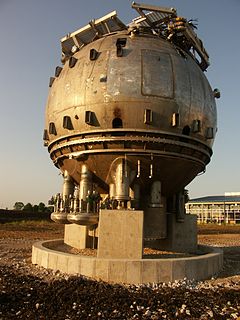
A bubble chamber is a vessel filled with a superheated transparent liquid used to detect electrically charged particles moving through it. It was invented in 1952 by Donald A. Glaser, for which he was awarded the 1960 Nobel Prize in Physics. Supposedly, Glaser was inspired by the bubbles in a glass of beer; however, in a 2006 talk, he refuted this story, although saying that while beer was not the inspiration for the bubble chamber, he did experiments using beer to fill early prototypes.
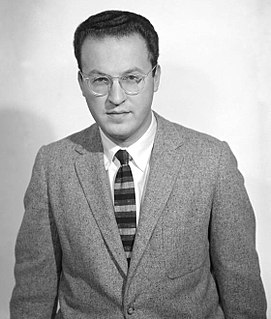
Donald Arthur Glaser was an American physicist, neurobiologist, and the winner of the 1960 Nobel Prize in Physics for his invention of the bubble chamber used in subatomic particle physics.

A cloud chamber, also known as a Wilson cloud chamber, is a particle detector used for visualizing the passage of ionizing radiation.

Gargamelle was a heavy liquid bubble chamber detector in operation at CERN between 1970 and 1979. It was designed to detect neutrinos and antineutrinos, which were produced with a beam from the Proton Synchrotron (PS) between 1970 and 1976, before the detector was moved to the Super Proton Synchrotron (SPS). In 1979 an irreparable crack was discovered in the bubble chamber, and the detector was decommissioned. It is currently part of the "Microcosm" exhibition at CERN, open to the public.
A wire chamber or multi-wire proportional chamber is a type of proportional counter that detects charged particles and photons and can give positional information on their trajectory, by tracking the trails of gaseous ionization.
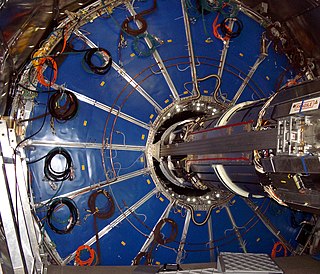
In physics, a time projection chamber (TPC) is a type of particle detector that uses a combination of electric fields and magnetic fields together with a sensitive volume of gas or liquid to perform a three-dimensional reconstruction of a particle trajectory or interaction.
The ionization chamber is the simplest of all gas-filled radiation detectors, and is widely used for the detection and measurement of certain types of ionizing radiation; X-rays, gamma rays, and beta particles. Conventionally, the term "ionization chamber" is used exclusively to describe those detectors which collect all the charges created by direct ionization within the gas through the application of an electric field. It only uses the discrete charges created by each interaction between the incident radiation and the gas, and does not involve the gas multiplication mechanisms used by other radiation instruments, such as the Geiger counter or the proportional counter.

Nucleation is the first step in the formation of either a new thermodynamic phase or a new structure via self-assembly or self-organization. Nucleation is typically defined to be the process that determines how long an observer has to wait before the new phase or self-organized structure appears. For example, if a volume of water is cooled below 0 °C, it will tend to freeze into ice, but volumes of water cooled only a few degrees below 0 °C often stay completely free of ice for long periods. At these conditions, nucleation of ice is either slow or does not occur at all. However, at lower temperatures ice crystals appear after little or no delay. At these conditions ice nucleation is fast. Nucleation is commonly how first-order phase transitions start, and then it is the start of the process of forming a new thermodynamic phase. In contrast, new phases at continuous phase transitions start to form immediately.

The Bevatron was a particle accelerator — specifically, a weak-focusing proton synchrotron — at Lawrence Berkeley National Laboratory, U.S., which began operating in 1954. The antiproton was discovered there in 1955, resulting in the 1959 Nobel Prize in physics for Emilio Segrè and Owen Chamberlain. It accelerated protons into a fixed target, and was named for its ability to impart energies of billions of eV.

The Proton Synchrotron (PS) is a particle accelerator at CERN. It is CERN's first synchrotron, beginning its operation in 1959. For a brief period the PS was the world's highest energy particle accelerator. It has since served as a pre-accelerator for the Intersecting Storage Rings (ISR) and the Super Proton Synchrotron (SPS), and is currently part of the Large Hadron Collider (LHC) accelerator complex. In addition to protons, PS has accelerated alpha particles, oxygen and sulphur nuclei, electrons, positrons and antiprotons.
George Ernest Kalmus, CBE, FRS is a noted British particle physicist.
PICO is an experiment searching for direct evidence of dark matter using a bubble chamber of chlorofluorocarbon (Freon) as the active mass. It is located at SNOLAB in Canada.

The Big European Bubble Chamber (BEBC) is a large size detector formerly used to study particle physics at CERN. The chamber body, a stainless-steel vessel, was filled with 35 cubic metres of superheated liquid hydrogen, liquid deuterium or a neon-hydrogen mixture, whose sensitivity was regulated by means of a movable piston weighing 2 tons. The liquids at typical operation temperatures around 27 K were placed under overpressure of about 5 atm. The piston expansion, synchronized with the charged particle beam crossing the chamber volume, caused a rapid pressure drop with in consequence the liquid reaching its boiling point During each expansion, charged particles ionized the atoms of the liquid as they passed through it and the energy deposited by them initiated boiling along their path leaving trails of tiny bubbles. These bubbles tracks were photographed by the five cameras mounted on top of the chamber. The stereo photographs were subsequently scanned and all events finally evaluated by a team of scientists. After each expansion, the pressure was increased again to stop the boiling. The bubble chamber was then ready again for a new cycle of particles beam exposure.
OPAL was one of the major experiments at CERN's Large Electron–Positron Collider. OPAL studied particles and their interactions by collecting and analysing electron-positron collisions. LEP was the largest particle accelerator in the world. There were three other experiments at LEP: ALEPH, DELPHI and L3.

The Berne Infinitesimal Bubble Chamber, BIBC, was almost pocket size, 6.5 centimetres across and with a visible volume containing about a wine glass of heavy liquid.

The 81 cm Saclay Bubble Chamber was a liquid hydrogen bubble chamber built at Saclay, in collaboration with the École Polytechnique (Orsay), to study particle physics. The team led by Bernard Gregory completed the construction of the chamber in 1960 and later it was moved to CERN and installed at the Proton Synchrotron(PS).
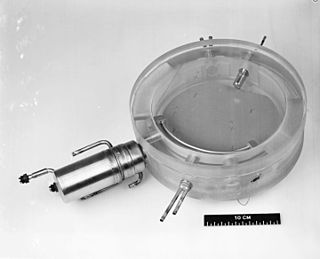
The construction of the LExan Bubble Chamber, LEBC, was approved by the CERN Research Board on 16 November 1978.

The 2m Bubble Chamber was a device used in conjunction with CERN’s 25 GeV Proton Synchrotron (PS) machine to study high-energy physics. It was decided to build this chamber in 1958 with a large team of physicists, engineers, technicians and designers led by Charles Peyrou. This project was of considerable magnitude, thus requiring a long-term planning so that all its characteristics could be carefully studied. Several models of this chamber were built and the problems encountered surpassed any of its predecessors. The construction only began three years later and in 1964 the chamber was finally commissioned. This chamber was devoted to the study of interaction mechanisms of high-energy particles and the investigation of the properties of their excited states.
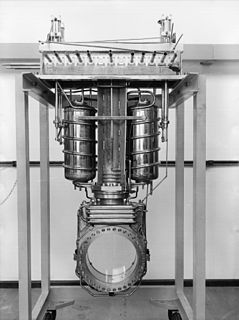
The 30 cm Bubble Chamber, prototyped as a 10 cm Bubble Chamber, was a particle detector used to study high-energy physics at CERN.

André Lagarrigue (1924 – 14 January 1975) was a French particle physicist. Being the initiator of the Gargamelle experiment at CERN, his work was of paramount importance in the discovery of neutral currents — the first experimental indication of the existence of the Z0 boson. This major discovery was a step towards verification of the electroweak theory, today a pillar of the Standard Model.
References
- ↑ Sutton, Christine (11 March 1982). New Scientist. Reed Business Information. pp. 646–649. ISSN 0262-4079.